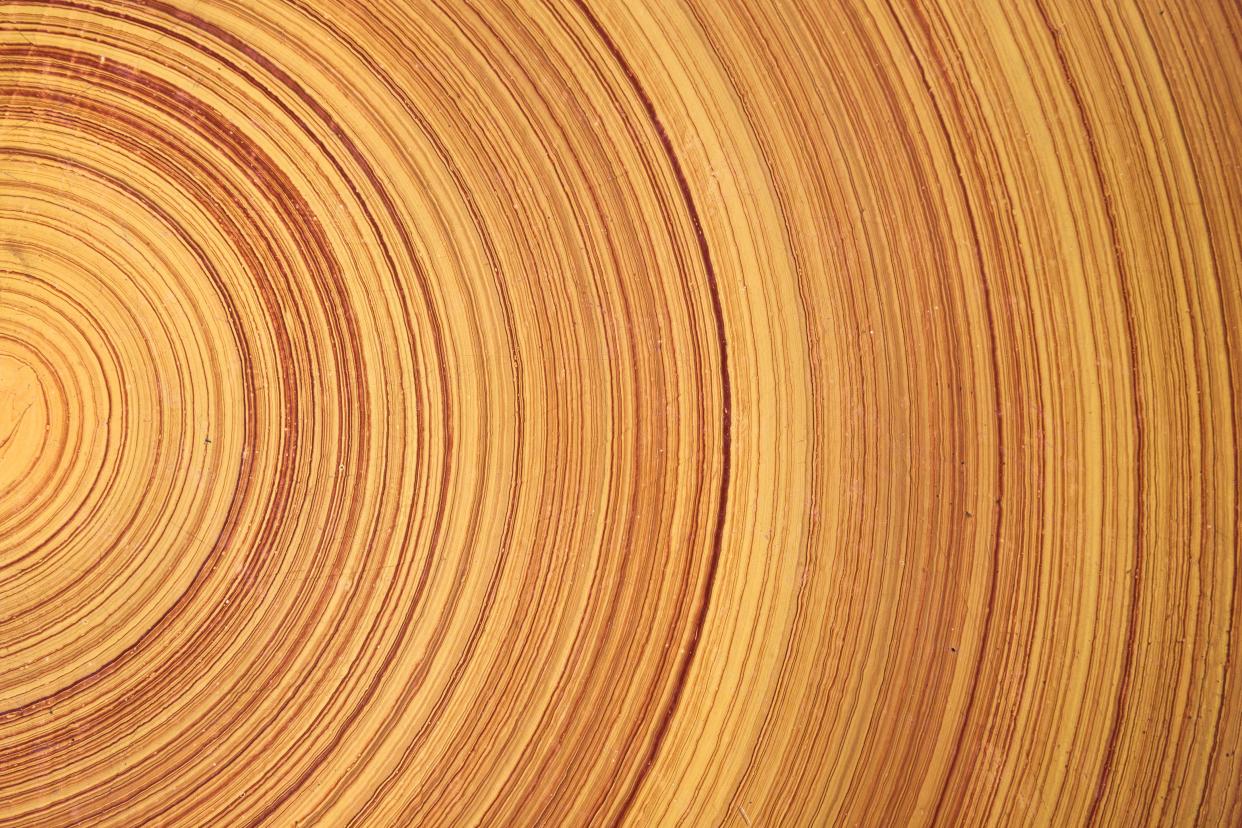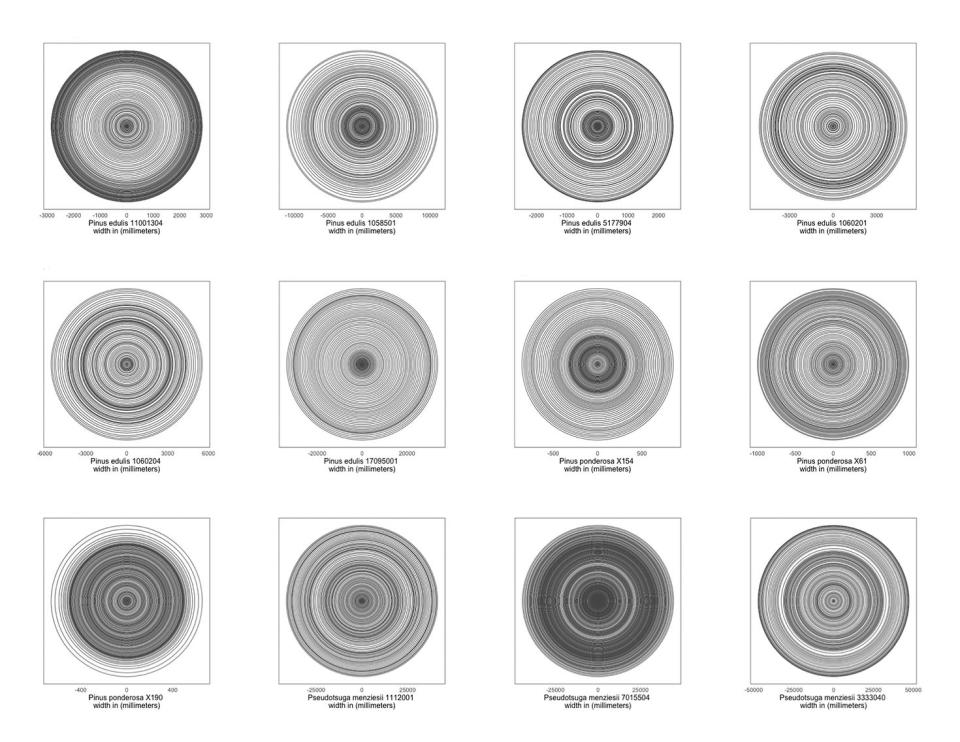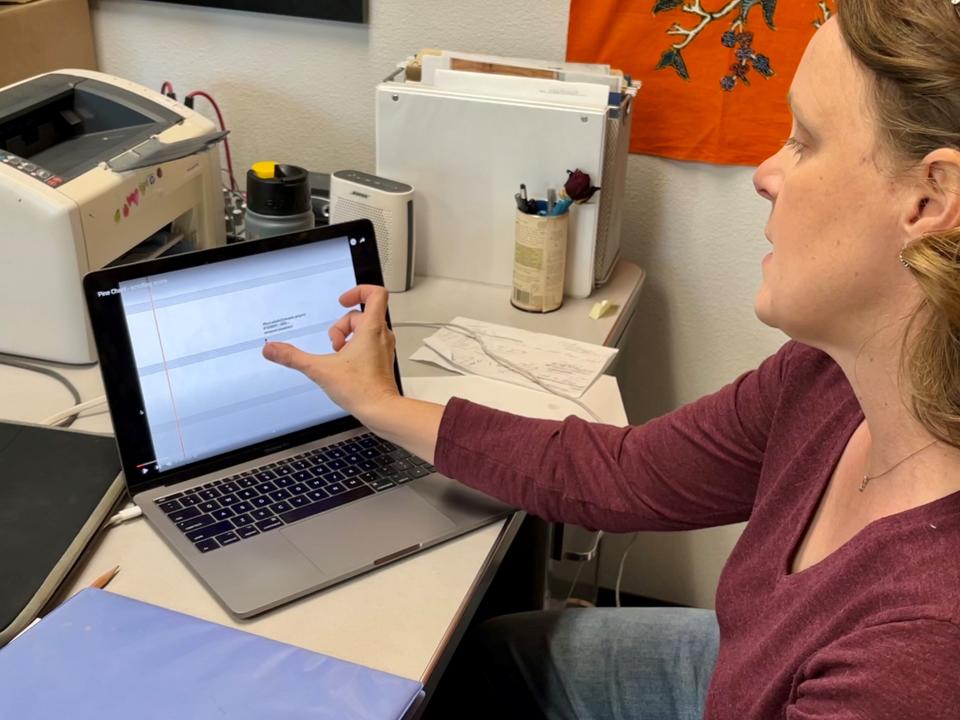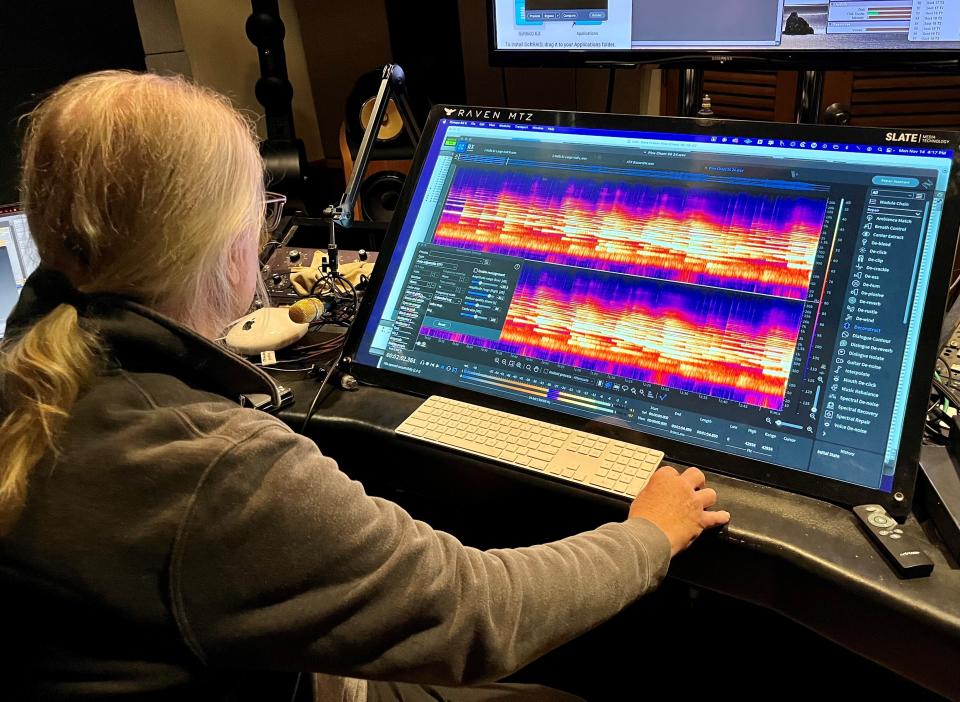Making tree rings sing: Researchers find musical muse in forest climate data

If a tree's rings are studied in a lab but no one hears them, do they make noise in the climate movement?
An associate professor of oboe at the University of Arizona wondered. It led her to team up with an Australian melodist and a Tucson dendrochronologist — a scientist who uses tree ring growth patterns to understand past variations in environmental conditions — to explore the connection between music, data and a changing planet.
The result is a hauntingly beautiful 13-minute composition of trees, by trees and for trees, performed by three woodwind instrumentalists as they stood dwarfed by an upright cross section of a giant sequoia in the lobby of the University of Arizona's Laboratory of Tree-Ring Research. Listen along at this link as you read on: https://youtu.be/JbOcRtZ9bd4.
Trees are some of nature's best scribes. They pull up available water and nutrients through their roots, and pull down energy from the sun and carbon dioxide from the air via the process of photosynthesis in their leaves. As they do, they grow wider by adding to their trunk circumference at its outside edge just beneath the bark, one new ring of cells at a time. In the spring, annual growth kicks off with a fresh layer of larger, lighter plant cells, visible in cross-section under a microscope, forming to the outside of a smaller, darker layer of cells that mark the end of the previous growing season.
During optimal years with plenty of resources and ideal conditions, the ring of fresh cell layers added to a tree's exterior will be thicker. In more bleak years, when the tree struggles with drought, unexpected freezes or withering temperatures, the evidence of stunted growth may appear as a ring that is thinner or fractured.
By taking cross sections or core samples of trees from forests exposed to different conditions and measuring the width of successive, completed rings in a lab, scientists who have learned to read this tree tome can reconstruct the climate's history from its pulpy text. The fact that carbon dioxide is necessary for plant growth and is also the most common greenhouse gas responsible for warming average global temperatures makes trees a convenient subject of study for climate scientists.
It also makes trees seem like a convenient solution to the climate crisis.
In 2015, at the United Nations climate conference in Paris, representatives from 196 countries hatched a plan to limit global warming to 1.5 degrees Celsius above pre-industrial levels in recognition of the need to address increasingly dangerous storms and global crop instability that scientists, by then, understood to be a consequence of climate change. This would require substantial reduction of carbon in the atmosphere. Forests, they decided, could accomplish about 25% of that goal by locking away carbon dioxide in the ring-shaped tissue of trees.
Since then, efforts to slow global deforestation, speed up afforestation (the planting of new trees) and improve forest management have been a central part of the climate conversation.
China's Great Green Wall Project aims to stabilize the climate of its expanding Gobi desert by planting 88 million acres of forest in a swath 900 miles wide and 3,000 miles long. In Africa, the similar Great Green Wall Initiative seeks to suck up 250 million tons of carbon while holding back the drying effects of the Sahara and Sahel deserts with a 4,300-mile wall of trees. In other desert regions, such as the U.S. Southwest, cities like Phoenix lean on trees as a way to increase urban shade and provide relief from increasingly deadly summer temperatures.
Shade trees, cool roofs:Here's how they can slow the billion-dollar drain of urban heat in Phoenix
A scientific report published in 2019 in the journal Science suggests that curbing climate-warming carbon concentrations by 25% could theoretically be possible with the global addition of 900 million hectares of forest. But a 2021 analysis by Our World in Data found that, despite afforestation efforts, the world is currently losing about 5 million hectares of forest each year to pressures like development, agricultural expansion and the influences of climate change.
In this warmed world of wilting and wildfires, Margaret Evans, associate professor of dendrochronology at the UA, thinks we're asking quite a lot of trees.
"We are planning on forests doing a lot for us in terms of carbon reductions, at the same time that we're seeing them go up in smoke."
Bell curves and reed frequencies
Evans studies, in her words, "your Joe Schmoe of trees" — the typical tree that makes up a Western forest. Using computing approaches borrowed from climate modelers, she wants to reduce the amount of uncertainty in predicting how forests will respond to a warmer and drier future.
"As a forest ecologist, I'm interested in how the climate is affecting your average trees in the forest," Evans said. "If you want to know how a forest is doing, you don't just want the most sensitive trees, which are the ones that allow (researchers) to reconstruct the history of the Colorado River, for example. You want the ones at both ends and at the middle of that bell curve."
Forests:Forests often regenerate after wildfires. Why the climate crisis could change that
Three typical species rounding out the bell curve of Arizona forests are the pinyon pine (Pinus edulis), the ponderosa pine (Pinus ponderosa) and the Douglas fir (Pseudotsuga menziesii). Pinyons grow to about 35 feet tall and 15 feet wide and are known as good habitat for birds and other wildlife. Ponderosas can reach 120 feet in height and have bark that smells of vanilla and butterscotch. Douglas firs have distinctive cones with a three-tipped lighter bract that, legend has it, are the tail and two hind feet of mice taking refuge from an advancing fire. All three species are susceptible to warming temperatures, drying soils and a variety of insect pests that take hold when the trees get stressed. Their fate will play a large role in how climate change shapes Arizona landscapes.

So when UA music professor Sara Fraker, a specialist on the oboe and the English horn, reached out with an idea to tell the climate story of Arizona's trees through the vibrating reeds of woodwind instruments, Evans knew just what data to use. She pulled in detailed tree ring growth records of 12 individual evergreen trees growing throughout Arizona — six Pinus edulis, three Pinus ponderosa and three Pseudotsuga menziesii — that had been mapped and visualized by Kelly Hielman, a postdoctoral member of Evans' research group. Then the women got to work figuring out how to make the tree rings sing.
Scaling science into sound
In Evans' office on the third floor of the UA tree-ring laboratory, Fraker smiles and alternates quickly snapping fingers on both hands to indicate an excited sense of synergy.
She's describing the moment she first walked into the building's lobby. It features a rounded exterior, horizontal wooden planks arranged at irregular intervals up the inside of the tall walls and large, wind-chime-like metal "leaves" adorning the outside perimeter.
"Square spaces kill sound," Fraker, said. "The music building doesn't have many right angles for that reason. And the tree ring building is round, to architecturally represent a tree. It felt like a perfect merging of architecture, shape, sound, data, wood material and science. We wanted the listener to be immersed and just enveloped in this sound that is alive and bouncy and reverberating."
Alive, bouncy and reverberating like a tree. It felt right.
Rodeo-Chediski FireIt forced people to flee their homes. Many returned, but with new anxiety
But she needed a composer who shared her vision. She soon found one in Australian Lachlan Skipworth.
"Sara Fraker had discovered and performed an earlier work of mine, a wind quintet called 'Echoes and Lines,'" Skipworth wrote in an emailed response to The Republic. "I jumped at the chance (to work with her on this). I was so amazed by the breadth of possibilities in the field of dendrochronology that I knew I simply had to write a good piece for this project."
They started a tree book club, reading Valerie Trouet’s “Tree Story: The History of the World Written in Rings” together for inspiration. Then, to represent the trio of Arizona tree species, they assembled a trio of wood-based musical instruments played by UA faculty — Fraker on an English horn made from an African mpingo tree (Dalbergia melanoxylon), Jackie Glazier on a clarinet of mpingo and Marissa Olegario on a bassoon of Maple (Acer sp.).
"We did not want it to be just this sonification project," Fraker said. "People are doing that, putting microphones into trees, and that's cool. But we wanted to do something different."

Measurements by Evans' team of the spacing between annual rings on the 12 individual trees guided Skipworth's spacing of the musical notes. Delayed breaths and pauses for long, healthy growing years. Tighter sequences in years strained by drought or cut short by a passing wildfire scarring the bark, pausing progress.
"For me the theme of climate change required a particularly sensitive treatment," Skipworth wrote. "I wanted to find a sound-world that reflected what is essentially a tragedy unfolding in slow motion before our eyes, while at the same time admitting the influence of the data itself. My solution was to fix particular musical elements and allow others to be free. Often this meant choosing a set of four chords and a creating melodic pathway through several cycles of these chords, but letting the data decide the rhythm. This means the flow of music through this pathway is dependent on the tree growth. At other times the data might additionally inform how many times a particular note is repeated, or the overall length of a particular gesture."
He also reverse-engineered an electronic component as a fixed part of the live performance that is derived from recorded notes breathed to life by the woodwind musicians. Then the pieces were all put back together, recorded live in the UA's sound studio over two days and blended to perfection by veteran resident sound engineer Wiley Ross, in an iterative revision process much like processes of adaptation found in nature itself.

That's the scientific part. The true magic of the piece, which they named "Pine Chant" to evoke the concept of a singing tree, comes from the complex interweaving of plant and human designs. Fraker even makes her own reeds for her English horn out of Arundo, a large-bamboo-like plant that grows as an invasive along Arizona waterways. She sometimes takes her students out with local environmental groups so they can harvest it themselves. Then this product of nature is dried, stripped and expertly fashioned into part of the mouthpiece used to tell this nature story.
"It's chamber music, so we do everything by mind-reading, body language, reading each other, all of that," Fraker said. "It's not just the trees. It's also the human response to what's happening."
The response to their seven live performances, which are now over, has far-reaching roots. Fraker hopes to continue working at the intersection of ecology and music. Evans is inspired by the interdisciplinary new use of her data. And Skipworth is now fully tuned into science.
"I’ve been reading a lot about the brain’s ability to process sound as music, which has caused a big rethink of my practice," he said. "I’m currently completing an oratorio tracing a refugee boy’s journey from the middle east to Australia via a network of people-smugglers. It’s a story of immense struggle but one that demonstrates the resilience of youth."
Read the series:The latest from Joan Meiners at azcentral, a column on climate change that publishes weekly
Toward the end of "Pine Chant" comes a warning about the resilience of forests.
The beginning of the piece feels relatively chaotic. Notes by the three instruments seem almost randomly timed and oddly overlapped. Then the pace and overlay picks up in the middle.
During the last few minutes of the recording, the instrument scores converge and there's a greater sense of harmony among them. It's the spacing data from the 12 trees entering an outer-ring phase of "wiggle matching," Evans said. She explained this concept to Fraker, who explained it to Skipworth, who composed it into the piece.
But on the note of climate impacts, the sequence is anything but harmonious.
"Trees in a forest being more synchronous in their ring spacing is an indicator of climate stress," Evans said.
In a healthy forest, some trees will be positioned in "climate refugia," spots that naturally pool more water or are less exposed to high temperatures, while less lucky trees nearby will show signs of strained growth. Ring spacing across a thriving forest will be diverse. When all the trees in an area have recent, outer rings showing hindered growth, those microclimates of tree refuge have become fewer and far between as surroundings warm and dry.
It's a reminder to make space to listen to old truths in new ways.
Joan Meiners is the Climate News and Storytelling Reporter at The Arizona Republic and azcentral. Before becoming a journalist, she completed a doctorate in Ecology. Follow Joan on Twitter at @beecycles or email her at joan.meiners@arizonarepublic.com.
Support climate coverage and local journalism by subscribing to azcentral.com at this link.
This article originally appeared on Arizona Republic: Tree ring science and music reverberate lessons on climate change

